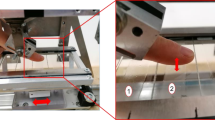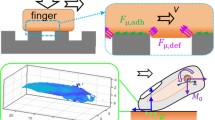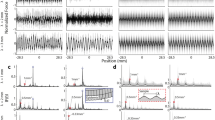Abstract
The surface topography of the human wrist skin is studied using an optical method and the surface roughness power spectrum is obtained. The Persson contact mechanics theory is used to calculate the contact area for different magnifications, for both dry and wet condition of the skin. For dry skin, plastic yielding becomes important and will determine the area of contact observed at the highest magnification. The measured friction coefficient [M.J. Adams et al., Tribol Lett 26:239, 2007] on both dry and wet skin can be explained assuming that a frictional shear stress σf ≈ 15 MPa acts in the area of real contact during sliding. This frictional shear stress is typical for sliding on polymer surfaces, and for thin (nanometer) confined fluid films. The big increase in the friction, which has been observed for glass sliding on wet skin as the skin dries up, can be explained as resulting from the increase in the contact area arising from the attraction of capillary bridges. This effect is predicted to operate as long as the water layer is thinner than ∼14 μm, which is in good agreement with the time period (of order 100 s) over which the enhanced friction is observed (it takes about 100 s for ∼14 μm water to evaporate at 50% relative humidity and at room temperature). We calculate the dependency of the sliding friction coefficient on the sliding speed on lubricated surfaces (Stribeck curve). We show that sliding of a sphere and of a cylinder gives very similar results if the radius and load on the sphere and cylinder are appropriately related. When applied to skin the calculated Stribeck curve is in good agreement with experiment, except that the curve is shifted by one velocity-decade to higher velocities than observed experimentally. We explain this by the role of the skin and underlying tissues viscoelasticity on the contact mechanics.















Similar content being viewed by others
Notes
See the ASHRAE Handbooks published by the technical organization American Society of Heating, Refrigerating and Air-Conditioning Engineers, Inc. (ASHRAE). This Handbook is considered the practical repository of knowledge on the various topics that form the field of heating, ventilation, air-conditioning, and refrigeration.
References
Adams, M.J., Briscoe, B.J., Johnson, S.A.: Friction and lubrication of human skin. Tribol. Lett. 26, 239–253 (2007)
Park, A.C., Baddiel, C.B.: Effect of saturated salt solutions on elastic properties of stratum corneum. J. Soc. Cosmet. Chem. 23, 3, 471–479 (1972)
Warman, P.H., Ennos, A.R.: Fingerprints are unlikely to increase the friction of primate fingerpads. J. Exp. Biol. 212, 2016–2022 (2009)
Derler, S., Gerhardt, L.-C.: Tribology of skin: review and analysis of experimental results for the friction coefficient of human skin. Tribol. Lett. 45, 1–27 (2012)
Persson, B.N.J.: Contact mechanics for randomly rough surfaces. Surf. Sci. Rep. 61, 201–227 (2006)
Persson, B.N.J., Albohr, O., Tartaglino, U., Volokitin A.I., Tosatti, E.: On the nature of surface roughness with application to contact mechanics, sealing, rubber friction and adhesion, J. Phys.: Condens. Matter 17, R1–R62 (2005)
Kendall, M.A.F., Carter, F.V., Mitchell, T.J., Bellhouse, B.J.: University of Oxfort, UK, research article: Comparison of the transdermal ballistic delivery of micro-particles into the human and porcine skin. http://www.dtic.mil/dtic/tr/fulltext/u2/a410062.pdf
Persson, B.N.J., Ganser, C., Schmied, F., Teichert, C., Schennach, R., Gilli, E., Hirn, U.: Adhesion of cellulose fibers in paper, subm. to J. Phys.: Condens. Matter
Persson, B.N.J.: Theory of rubber friction and contact mechanics. J. Chem. Phys. 115, 3840–3861 (2001)
O’Sullivan, T.C., King, R.B.: Sliding contact stress-field due to a spherical indenter on a layered elastic half-space. ASME J. Tribol. 110, 235–240 (1988)
Persson, B.N.J.: Contact mechanics for layered materials with randomly rough surfaces. J. Phys.: Condens. Matter 24, 095008 (2012)
Carbone, G., Lorenz, B., Persson, B.N.J., Wohlers, A.: Contact mechanics and rubber friction for randomly rough surfaces with anisotropic statistical properties. Eur. Phys. J. E. 29, 275–284 (2009)
Sivebaek, I.M., Samoilov, V.N., Persson, B.N.J.: Frictional properties of confined polymers. Eur. Phys. J. E. 27, 37–46 (2008)
Sivebaek, I.M., Samoilov, V.N., Persson, B.N.J.: Effective viscosity of confined hydrocarbons. Phys. Rev. Lett. 108, 036102 (2012)
Persson, B.N.J.: Capillary adhesion between elastic solids with randomly rough surfaces. J. Phys.: Condens. Matter 20, 315007 (2008)
Persson, B.N.J., Volokitin, A.I., Tosatti, E.: Role of the external pressure on the dewetting of soft interfaces. Eur. Phys. J. E. 11, 409–413 (2003)
Deleau, F., Mazuyer, D., Koenen, A.: Sliding friction at elastomer/glass contact: influence of the wetting conditions and instability analysis. Tribol. Int. 42, 149–159 (2009)
Wangenheim, M., Kröger, M.: Friction phenomena on microscale in technical contacts with rubber. Proceedings 9th ASME Conference on Engineering Systems Design and Analysis 3, ESDA (2008), Haifa, Israel. S., pp. 541–547
Homann, H.: Haften Spinnen an einer Wasserhaut. Naturwissenschaften 44, 318–319 (1957). doi:10.1007/BF00630926
Huber, G., Mantz, H., Spolenak, R., Mecke, K., Jacobs, K., Gorb, S.N., Arzt, E.: Evidence for capillarity contributions to gecko adhesion from single spatula nanomechanical measurements. Proc. Natl Acad. Sci. USA 102, 16293–16296 (2005). doi:10.1073/pnas.0506328102
Niewiarowski, P.H., Lopez, S., Ge, L., Hagan, E., Dhinojwala, A.: Sticky gecko feet: the role of temperature and humidity. PLoS ONE 3, e2192 (2008). doi:10.1371/journal.pone.0002192
Wolff, J.O., Gorb, S.N.: The influence of humidity on the attachment ability of the spider Philodromus dispar (Araneae, Philodromidae). Proc. R. Soc. B 279, 139–143 (2012). doi:10.1098/rspb.2011.0505
Gerhardt, L.-C., Strssle, V., Lenz, A., Spencer, N.D., Derler, S.: Influence of epidermal hydration on the friction of human skin against textiles. J. R. Soc. Interface 5, 1317–1328 (2008)
Hendriks, C., Franklin, S.: Influence of surface roughness, material and climate conditions on the friction of human skin. Tribol. Lett. 37, 361–373 (2010)
Kwiatkowska, M., Franklin, S.E., Hendriks, C.P., Kwiatkowski, K.: Friction and deformation behaviour of human skin. Wear 267, 1264–1273 (2009)
Tomlinson, S.E., Lewis, R., Liu, X., Texier, C., Carr, M.J.: Understanding the friction mechanisms between the human finger and flat contacting surfaces in moist conditions. Tribol. Lett. 41, 283–294 (2011)
Pasumarty, S.M., Johnson, S.A., Watson, S.A., Adams, M.J.: Friction of the human finger pad: influence of moisture, occlusion and velocity. Tribol. Lett. 44, 117–137 (2011)
Persson, B.N.J., Scaraggi, M.: On the transition from boundary lubrication to hydrodynamic lubrication in soft contacts. J. Phys.: Condens. Matter 21, 185002 (2009)
Persson, B.N.J., Scaraggi, M.: Lubricated sliding dynamics: flow factors and Stribeck curve. Eur. Phys. J. E 34, 113 (2011)
Scaraggi, M., Carbone, G., Persson, B.N.J., Dini, D.: Lubrication in soft rough contacts: a novel homogenized approach. Part I—theory. Soft Matter 7, 10395–10406 (2011)
Johnson, K.L.: Contact Mechanics, p. 452. Cambridge University Press, Cambridge (1966)
Bowen, J., Cheneler, D., Andrews, J.W., Avery, A.R., Zhand, Z., Ward, M.C.L., Adams, M.J.: Application of colloid probe atomic force microscopy to the adhesion of thin films of viscous and viscoelastic silicone fluids. Langmuir 27, 11489–11500 (2011)
Stephens, T.S., Winter, H.H., Gottlieb, M.: The steady shear viscosity of filled polymeric liquids described by a linear superposition of 2 relaxation mechanisms. Rheol. Acta 27, 263–272 (1988)
Johnson, S.A., Gorman, D.M., Adams, M.J., Briscoe, B.J.: The friction and lubrication of human stratum corneum. In: D. Dowson et al (eds.) Thin films in technology, pp 663–672. Elsevier Science Publishers (1993)
Persson, B.N.J.: Rolling friction for hard cylinder and sphere on viscoelastic solid. Eur. Phys. J. E. 33, 327–333 (2010)
Tomlinson, S.E., Lewis, R., Carre, M.J.: The effect of normal force and roughness on friction in human finger contact. Wear 267, 1311–1318 (2009)
Vincent, J.F., Wegst, U.K.: Design and mechanical properties of insect cuticle. Arthr. Str. Dev. 33, 187–199 (2004). doi:10.1016/j.asd.2004.05.006
Puthoff, J.B., Prowse, M.S., Wilkinson, M., Autumn, K.: Changes in materials properties explain the effects of humidity on gecko adhesion. J. Exp. Biol. 213, 3699–3704 (2010). doi:10.1242/jeb.047654
Richards, S.C., Roberts, A.D.: Boundary lubrication of rubber by aqueous surfactant. J. Phys. D 25, A76–A80 (1992)
Geerligs, M.: A literature review of the mechanical behaviour of the stratum corneum, the living epidermis and the subcutaneous fat tissue, Technical Note PR-TN 2006/00450, Koninklijke Philips Electronics N.V. (2006)
Acknowledgments
We thank M.J. Adams and S.A. Johnson for useful communications, and for sending us their surface topography data for skin.
Author information
Authors and Affiliations
Corresponding author
Appendices
Appendix A: Capillary Adhesion; Role of Humidity
In Sect. 5, we studied the influence of relative thick water films (average film thickness of order ∼1−10 μm) on the skin-glass contact mechanics. Such film thickness prevail, for example, during drying of an originally flooded contact. Similar film thickness may prevail during sweating. Here, we consider instead the skin in equilibrium with humid air as a function of the air relative humidity. For most humidity this implies water film thickness of order nanometers.
Figure 16 shows the logarithm (with 10 as basis) of the relative contact area as a function of the relative humidity. If the elastic modulus of the stratum corneum would take the same value as in the wet (or 100% relative humidity) state, E 0 ≈ 7 MPa, for all relative humidity, then capillary adhesion for small relative humidity would be strong enough to bring the surfaces into nearly complete contact. However, in reality the elastic modulus rapidly increases with decreasing relative humidity (see Fig. 17), and the influence of the capillary adhesion for relative humidity below 90% is negligible. This is illustrated in Fig. 16 with a calculation with E 0 = 70 MPa, for which case the area of real contact is nearly independent of the relative humidity and determined by the applied load or pressure.
The logarithm (with 10 as basis) of the relative contact area as a function of the relative humidity. If the elastic modulus of the stratum corneum would take its wet (or 100% relative humidity) value, E 0 = 7 MPa, for all relative humidity’s, the capillary adhesion for small relative humidity would be strong enough to bring the surfaces into nearly complete contact. However, in reality the elastic modulus rapidly increases with decreasing relative humidity and the influence of the capillary adhesion for relative humidity below 90% is negligible. This is illustrated with a calculation with E 0 = 70 MPa for which case the area of real contact is nearly independent of the relative humidity and determined by the applied load or pressure. For the applied pressure p 0 = 6.83 kPa
The logarithm (with 10 as basis) of the Young’s elastic modulus of the stratum corneum as a function of the relative humidity. The blue line is an approximate cubic spline fit to the experimental data. Based on experimental data obtained by Park and Baddiel, Papir, Koutroupi, Nikolopoulos, Gardner and Briggs and Yuan and Verma. Adopted from [41]
The calculation presented above (and in Ref. [15]) shows that if an elastic solid is soft enough, for a smooth hydrophilic interface there will be a strong increase in the contact area for some humidity range. This effect may be important in many situations, e.g., for rubber friction involving smooth hydrophilic interfaces, since the elastic modulus of rubber is nearly independent of the humidity and of similar magnitude as that of wet stratum corneum. This may contribute to the friction for, e.g., rubber wiper blades sliding on glass [17].
Appendix B: Mixed Lubrication; Approximate Mapping of Elliptic Contact on Cylinder Contact
In Sect. 6.1 we have shown how one can (approximately) map the sliding dynamics of a sphere on a lubricated substrate on a problem of a cylinder sliding on the same substrate, which is useful from a computational point of view, but also interesting from a conceptional point of view. This type of mapping should be even more accurately for a Hertz elliptic contact with the sliding direction orthogonal to the major elliptic axis (see Fig. 18).
We determine the radius of the cylinder and the load on the cylinder so that (a) the average Hertz contact pressure are the same, and (b) so that the condition \(r_{\rm e} =w \sqrt(2/3)\) is satisfied, where w is the width of the Hertz infinite rectangular contact strip for the cylinder, and r e an effective radius of the elliptic contact region defined by:
The latter condition guaranty the same fluid squeeze-out time for an infinite rectangular sheet (width w) as for an elliptic disk (with the major and minor axis a and b) (both rigid and with identical applied squeezing pressures). For the special case of a circular contact region, a = b = r 0 so that r e = r 0 and the condition above reduces to \(r_0 =w \sqrt(2/3)\) which was used in Sect. 6.1.
Assume that the interfacial separation h(x, y) between the (undeformed) surfaces is of the form
We define the effective radius R e = (R 1 R 2)1/2. Thus for a sphere (radius R s) in contact with the flat R 1 = R 2 = R s and R e = R s. The Hertz elliptic contact mechanics can be expressed using the complete elliptic integral of the first K(x) and the second E(x) kind, which are easy to evaluate using the integral representations
and
Defining
where
we can write the average contact pressure \(\bar{p}_{\rm e}\) and the radius r e as [31]
where
Thus, we get
where
In Fig. 19, we show C e/C and C e′/C′ as a function of a/b.
Appendix C: Stribeck Curve for Skin; Role of Shear Thinning and Flow Factors
In Sect. 6.2, we have calculated the Stribeck curve for a hard sphere sliding on lubricated skin and compared to experiments where the skin where lubricated with silicon oil of different viscosity’s. The calculated Stribeck curve is similar to the measured one but shifted by a factor ∼20 to higher sliding velocity than observed. We have presented a tentative explanation for this related to the viscoelastic nature of the human skin and underlying tissues. In this section, we show that the deviation between experiment and theory cannot be attributed to inaccuracy in the fluid flow factors or shear thinning of the silicon oil since both effects gives very small changes in the Stribeck curve. We attribute this insensitivity of the Stribeck curve to the flow factors and shear thinning to the small contact pressure and large (average) interfacial separation even in the boundary lubrication region.
The fluid flow at the interface between solids with surface roughness is a very complex problem. However, if the surface roughness gradient is not too large one may average the basic equations of fluid flow over the surface roughness and obtain effective equations for smooth surfaces. In the effective equations enters the pressure and shear flow factors ϕp and ϕs which depends on the (average) local interfacial separation \(\bar{u}. \) For smooth surfaces ϕp = 1 and ϕs = 0 which we refer to as trivial pressure and shear flow factors. Similarly in the expression for the frictional shear stress enters three frictional shear stress factors ϕf, ϕfs and ϕfp which are also functions of \(\bar{u}. \) For smooth surfaces ϕf = ϕfp = 1, and ϕfs = 0, which we refer to as trivial friction factors. In Ref. [29] one of us have shown how all these functions can be calculated in an approximate but accurate way, and we used this theory in the numerical calculations of the Stribeck curve presented in this article.
Figure 20 shows the calculated Stribeck curve including all fluid flow and frictional shear stress factors (red curve), and for trivial fluid flow and frictional shear stress factors (blue curve). There is negligible difference between the two curves and we conclude that an accurate knowledge of the fluid flow and frictional shear stress factors is not necessary for the present problem due to the large average separation between the surfaces.
Figure 21 shows the calculated Stribeck curve for fluids with the (low-shear rate) viscosity’s \(\eta_0 = 0.01, 0.1, \ldots, 100 \,{\rm Pa s}\) including shear thinning. The shear thinning is described by using the effective viscosity [29, 33, 34]
where (using SI units) B = 104 and n = 0.8. The shear rate \(\dot \gamma = v/u\) (where u is the film thickness). This expression for the effective viscosity describes accurately the shear thinning of silicon oils of different viscosity’s [33, 34]. Not that shear thinning start at lower shear rate as the low-shear rate viscosity η0 increases. Thus, shear thinning becomes important when \(\dot \gamma > \dot \gamma_{\rm c} = (B/\eta_0)^{1/n}. \) For example, for η0 = 1 Pa s shear thinning start when \(\dot \gamma > \dot \gamma_{\rm c} \approx 10^5 \,{\rm s}^{-1}. \) Note that including shear thinning has a negligible influence on the Stribeck curve. This is again due to the low contact pressure and large average interfacial separation in the present case.
Rights and permissions
About this article
Cite this article
Persson, B.N.J., Kovalev, A. & Gorb, S.N. Contact Mechanics and Friction on Dry and Wet Human Skin. Tribol Lett 50, 17–30 (2013). https://doi.org/10.1007/s11249-012-0053-2
Received:
Accepted:
Published:
Issue Date:
DOI: https://doi.org/10.1007/s11249-012-0053-2










